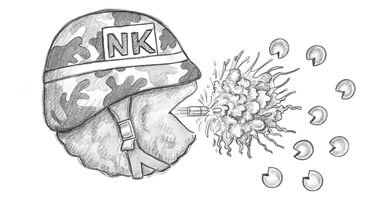The Immune System Army
An army of millions of microscopic soldiers operates within you, each one ready to spring into battle against invading germs and to do sentry duty to prevent disease from occurring in the first place. How you feed these soldiers has a great influence on how well they protect you from germs and disease. Because of poor diets, many school-age children and adults have immune systems that don’t operate at peak efficiency. They get sick more often. Here’s how to have a well-nourished immune system.
Think of the immune system as an army in which each division has a specific job, depending on the enemy they are fighting. Let’s meet the troops to see what each kind of defender does.
White blood cells are the body’s infantry, the hard-working soldiers on the front lines. These cells patrol the highway of the body’s bloodstream, preventing germs from gaining a foothold. There are millions of these microscopic fighters in each drop of blood. There are also many specialized units. For example, when enemy cells try to hide from the main white cell troops, specialized units of white cells, called macrophages (the word means “big eaters”), mount search-and-destroy missions, going into all the nooks and crannies of the body to gobble up harmful invaders.
Suppose a flu virus enters your body, multiplies rapidly, and threatens to overwhelm the circulating white cell army. The main troops can call out the reinforcements. These specialized cells include T-lymphocytes (white cells that originate in the thymus, a tiny gland in front of the heart) and even a special SWAT team called killer lymphocytes.
Antioxidants are Awesome
The human body is the most marvelous machine ever made. Like your car engine producing exhaust from burning fuel, your body’s “engine”—its metabolism—produces “exhaust” called oxidants, by-products of cellular metabolism. Oxidants (also called “free radicals”), if produced in just the right amount, act like microscopic antibiotics to attack germs that get into the cell. Yet, an excess of this exhaust (called oxidative stress) damages cells and tissues.
Antioxidants help to prevent damage from carcinogens such as tobacco smoke and other environmental pollutants. The antioxidants that your body makes and the ones you eat in smart foods and supplements act like microscopic fire extinguishers to blunt tissue damage from the exhaust of your natural metabolism. Health is oxidant/antioxidant balance. Illness is an imbalance. Oxidation balance is your goal. Just like mental stress is bad for the mind and body, so is excess biochemical stress. Enter antioxidants, molecules you make and eat to mute the damaging effects of oxidative stress.
Your body makes glutathione, your master antioxidant, to neutralize the excess oxidants. Yet, as we age, the body’s ability to make glutathione gets weaker.
Chemical Messengers and Fighters
The immune army has a magnificent communication system. If a germ enters the body through a break in the skin or maybe an infection in the throat the white cells send out chemical messengers that quickly mobilize reinforcements and direct them to the area of infection. Once they reach the battle, these cells produce chemical fighters, known as cytokines (meaning molecules that move to the cells). These cytokines perform all kinds of functions around the infection site to surround the invaders and heal the havoc the enemy has created. They dilate the blood vessels, causing more blood flow and enabling more white cell police to enter the infected area of battle. One well-known cytokine, interferon, even sends a signal back to command headquarters to tell the brain the body needs to rest. This allows the body to concentrate its energies on the battle against the disease. Another important cytokine is called the tumor necrosis factor. It can gobble up cancer cells that are acting like traitors and weakening the body from within. Another task of these cytokine messengers is to tell the body to conserve supplies, such as important nutrients that are needed to win the infection battle. For example, the command center instructs the body to hold onto immune-boosting elements, such as zinc, rather than eliminating it through the kidneys.
Chemical Weapons
My favorite fighters in your immune system army are lymphocytes called natural killer cells (NK cells). These are the “Navy Seals” of your immune system. They are well-trained soldiers that are on-call for search-and-destroy missions to detect cancer cells and germs. When an NK cell finds a cancer cell, it “gloms” onto it and shoots biochemical bullets (called perforins) into the cell and kills it. The defeated and deflated cancer cell then becomes cellular garbage, which is removed by macrophages (“big eaters”), the garbage collectors of the immune system.
The immune army also guards strategic entry points to the body, such as the respiratory and gastrointestinal tracts. Within the mucus that lines these passages, specialized immunoglobulin antibodies called secretory IgA patrol the walls and prevent bacteria and allergens from invading the tissues.
The most fascinating aspect of this immune army is the remarkable memory it possesses. It remembers every past battle and learns from experience. If the same, or a similar, germ tries to attack again, the army is ready for it. It recognizes the invader and pounces on it, winning every time. This is the rationale behind immunizations. The small dose of killed virus given in an immunization sets up a training exercise for the immune army. It uses the lessons learned in training to overcome threats from the real germ.
Problems in the Ranks
While the immune system works well most of the time, some germs, like the herpes virus, are particularly adept at evading attacks. Herpes can lie undetected in the tissues for long periods of time, only to come out and spread when the army’s defenses are down. Then it retreats back into its hideout, lying dormant for months or years before it wages another attack. Some viruses, such as HIV, can even hide within the immune system itself, infiltrating the ranks of the army and destroying it from within.
Cancer cells are another tough challenge to the immune system. These are cells whose internal control mechanism is damaged, allowing the cells to multiply out of control. Most of the time the immune army quickly recognizes these “criminal” elements and eliminates or jails them before they cause damage. Sometimes the cancer culprits go unnoticed for a while, and by the time they are detected, the immune system is powerless to stop them. The battle spreads to other parts of the body (a disease process called metastasis).
Sometimes the immune army mutinies and attacks the very organs it is supposed to defend. Examples of this include diseases such as arthritis (antibodies attacking tissues of the joints), diabetes (antibodies attacking insulin-producing cells in the pancreas), and perhaps multiple sclerosis (in which the immune system may be attacking the myelin sheath of the nerves).
Finally, there are times when the immune system overreacts, in effect, burning an entire village to kill a few terrorists. This hypersensitive response can be triggered with and allergy. The army of white cells not only engulfs the invading allergen, such as a particle from a dust mite in the bedroom, but also releases enough chemicals in this battle to cause other problems, such as wheezing or rashes.
Learn more in our book, The Dr. Sears T5 Wellness Plan.

